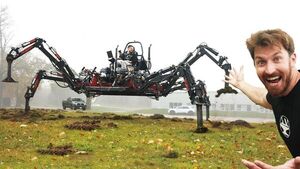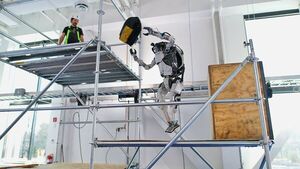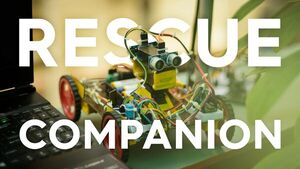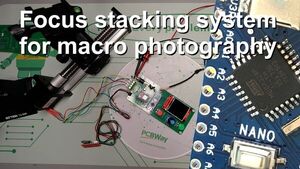2023-01-19 - Nº 403
Editorial
Esta é a Newsletter Nº 403 que se apresenta com o mesmo formato que as anteriores. Se gostar da Newsletter partilhe-a!
Todas as Newsletters encontram-se indexadas no link.
Esta Newsletter tem os seguintes tópicos:
Faz hoje anos que nascia, em 1736, o engenheiro e inventor escocês James Watt. Ele criou a máquina a vapor que contribuiu substancialmente para a Revolução Industrial. Em 1763 reparou o modelo da máquina a vapor Newcomen pertencente à Universidade de Glasgow, e iniciou experiências sobre as propriedades do vapor. O motor Newcomen era de concepção simples: actuava como uma bomba e um jacto de água fria era utilizado para condensar o vapor. Watt melhorou este design ao adicionar um condensador separado e um sistema de válvulas para fazer o pistão regressar ao topo do cilindro após a descida. Em 1769, ele levou uma patente para o condensador separado. Mais tarde, adaptou o motor ao movimento rotativo, tornando-o adequado para uma variedade de fins industriais, e inventou o volante de inércia e o regulador.
Faz também hoje anos que nascia, em 1747, o astrónomo alemão Johann Elert Bode. Ele ficou conhecido pela sua popularização da lei de Bode. Em 1766, o seu compatriota Johann Titius tinha descoberto uma curiosa relação matemática nas distâncias dos planetas em relação ao sol. Se a cada número da série 0, 3, 6, 12, 24,... e as respostas divididas por 10, a sequência resultante dá as distâncias dos planetas em unidades astronómicas (terra = 1). Também conhecida como a lei Titius-Bode, a ideia caiu em descrédito após a descoberta de Netuno, que não está em conformidade com a 'lei' - nem Plutão. Bode foi director no Observatório de Berlim, onde publicou Uranographia (1801), uma das primeiras tentativas bem sucedidas de mapear todas as estrelas visíveis a olho nu sem qualquer interpretação artística das figuras das constelações estelares.
Por fim, faz hoje anos que nascia, em 1813, o industrialista, metalúrgico, inventor e engenheiro inglês Henry Bessemer. Ele desenvolveu o primeiro processo de fabrico de aço de forma barata (1856), levando ao desenvolvimento do conversor de Bessemer. Bessemer inventou o seu processo de fabrico de aço para resolver um problema específico que perturbava outra das suas invenções, a concha de artilharia autogravada. O conversor removeu as impurezas do ferro fundido por oxidação através do ar a ser soprado através do ferro fundido. A oxidação também aumentou a temperatura da massa de ferro, mantendo-a derretida. O processo de oxidação removeu impurezas tais como silício, manganês, e carbono como óxidos, que os óxidos ou escapam como gás ou formam uma escória sólida. Ele também resolveu problemas sobre a química dos minérios, combustíveis e aço. Detinha 110 patentes aquando da sua morte.
Na Newsletter desta semana apresentamos diversas noticias, artigos científicos, projetos de maker e alguns vídeos interessantes. É apresentado a HackSpace Magazine nº63 de Fevereiro.
 João Alves ([email protected])
João Alves ([email protected])
O conteúdo da Newsletter encontra-se sob a licença  Creative Commons Attribution-NonCommercial-ShareAlike 4.0 International License.
Creative Commons Attribution-NonCommercial-ShareAlike 4.0 International License.
Novidades da Semana
Outras Notícias
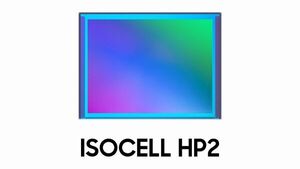
Samsung Introduces the 200-Megapixel Image Sensor for the Ultimate High Resolution Experience in Flagship Smartphones
"The new Samsung ISOCELL HP2 boosts capacity for maximum pixel performance, allowing for detailed and seamless photos in any light condition Samsung Electronics today introduced its latest 200-megapixel (MP) image sensor, the ISOCELL HP2, with improved pixel technology and full-well capacity for stunning mobile images in tomorrow’s premium smartphones. “The Samsung ISOCELL HP2 harnesses Samsung’s high-resolution image sensor technologies and know-how at the cutting edge for epic details,” said JoonSeo Yim, Executive Vice President of Sensor Business Team at Samsung Electronics. “Our leadership comes from innovative pixel technologies that allow our sensors to go beyond the number and size of pixels. We will continue to open new horizons and solidify our presence in the expanding ultra-high-resolution sensor market.” The ISOCELL HP2 packs 200-million 0.6-micrometer (μm) pixels in a 1/1.3” optical format, a sensor size that is widely used in 108MP main smartphone cameras. This enables consumers to enjoy even higher resolutions in the latest high-end smartphones without larger camera bumps in their devices. With Samsung’s advanced pixel-binning technology, Tetra2pixel, the HP2 adds more versatility to the camera as it simulates different pixel sizes to accommodate varying lighting levels." [...]

Renesas’ New Automotive Intelligent Power Device Enables Safe and Flexible Power Distribution in Next-Generation E/E Architectures
"The New Power Device Achieves a 40% Smaller Footprint. Renesas Electronics Corporation (TSE: 6723), a premier supplier of advanced semiconductor solutions, announced today a new automotive Intelligent Power Device (IPD) that will safely and flexibly control power distribution within vehicles, addressing the requirements of next-generation E/E (electrical/electronic) architectures. The new RAJ2810024H12HPD is available in the small TO-252-7 package and reduces the mounting area by about 40% compared to the conventional TO-263 package product. In addition, the advanced current detection function of the new device allows highly accurate detection of abnormal currents such as overcurrent. Since the new IPD detects abnormal currents even at low loads, it allows engineers to design highly safe and precise power control systems that can detect even the smallest abnormalities. "We are very pleased to launch a new generation of automotive IPDs featuring our new power MOSFET process,” said Akira Omichi, Vice President of Renesas' Automotive Analog Application Specific Business Division." [...]

STMicroelectronics’ dual-channel digital isolators cover flexible configurations
"STMicroelectronics has extended its family of dual-channel high-speed digital isolators, enhancing flexibility for designers to optimize their board layout. The new STISO620 contains two channels of the same directionality, having all digital inputs on one side of the isolation barrier and all digital outputs on the other side. It joins ST’s digital isolator lineup alongside the STISO621 and STISO621W that provide one channel in each direction. The family thus offers a convenient solution for many applications that need to isolate two digital signals and transfer the digital communication across the isolation barrier with flexible directionality. All the isolators are based on ST’s 6kV thick-oxide technology that ensures robust galvanic isolation. Built to maintain insulation integrity during system faults and with aging, they enhance reliability in industrial and consumer applications." [...]

New All-in-One Hybrid Power Drive Module Solution from Microchip is Designed for Electric Aviation Applications to Reduce Development Time and Weight
"The highly integrated and configurable three-phase power module is the first variant of the new family and can be customized using silicon carbide or silicon, reducing power solution size and weight for electric aircraft Aircraft manufacturers designing More Electric Aircraft (MEA) are looking to convert the flight control systems from hydraulic to electric to reduce weight and design complexities. To meet the needs for an integrated and configurable power solution for aviation applications, Microchip Technology Inc. (Nasdaq: MCHP) today announces a new comprehensive hybrid power drive module, the first variant introduced in the new product line of power devices that will be available in 12 different variants with either silicon carbide (SiC) MOSFETs or insulated-gate bipolar transistors (IGBTs). These hybrid power drive modules are highly integrated power semiconductor devices that reduce the number of components and simplify the overall system design. The configurable power devices include a three-bridge topology that are available in SiC or Si semiconductor technologies. Offering a compact design and low weight and profile, these high-reliability power devices help reduce the size and weight of MEAs. Other key capabilities of these hybrid power drive modules include numerous auxiliary power devices that facilitate an inrush current limit function." [...]

NASA Issues Award for Greener, More Fuel-Efficient Airliner of Future
"NASA announced Wednesday it has issued an award to The Boeing Company for the agency’s Sustainable Flight Demonstrator project, which seeks to inform a potential new generation of green single-aisle airliners. Under a Funded Space Act Agreement, Boeing will work with NASA to build, test, and fly a full-scale demonstrator aircraft and validate technologies aimed at lowering emissions. Over seven years, NASA will invest $425 million, while the company and its partners will contribute the remainder of the agreement funding, estimated at about $725 million. As part of the agreement, the agency also will contribute technical expertise and facilities. “Since the beginning, NASA has been with you when you fly. NASA has dared to go farther, faster, higher." [...]

China's Mingyang looks 'beyond 18MW' with 140-metre blade offshore wind turbine giant
"Manufacturer claims latest leap in size and power means machine can supply almost 100,000 people and slash build costs. Mingyang Smart Energy set out its stall to take China’s offshore wind industry to a new level of ultra-large turbines with its latest 140-metre-blade MySE 18.X-28X to “move beyond the 18MW threshold”. The giant machine, unveiled by the Chinese OEM today (Friday), boasts a rotor diameter above 280 metres and 66,000m2 swept area, said Mingyang as it joined compatriot CSSC Haizhuang at the 18MW mark and suggested there is more to come. The manufacturer claimed at an average 8.5 metres/second the turbine will generate 80GWh annually, enough to supply almost 100,000 people, in the latest in a seemingly endless string of announcements from China's wind industry seeking to push the boundaries of technology in the sector. “When compared to the installation of 13MW models, the higher output of the MySE18.X-28X would save 18 units required for a 1GW wind farm, shaving off construction costs by $120,000-150,000 per megawatt,” it said, adding that the turbine would be able to cope with extreme conditions such as a level-17 typhoons with 56 metre/second wind speeds. There was no indication of production timelines or other details of commercial introduction plans in a brief statement announcing the launch on social media." [...]
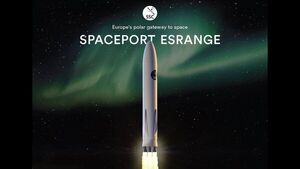
The world watched the inauguration of Spaceport Esrange
"On Friday 13th 2023, SSC inaugurated mainland EU’s first orbital launch site: Spaceport Esrange. Before the eyes of the whole world, the ribbon was cut by the Swedish Head of State, King Carl XVI Gustaf, the President of the European Commission, Ursula von der Leyen, and the Swedish Prime Minister, Ulf Kristersson. Now begins a new era for Esrange Space Center and Europe with an expected first satellite launch in early 2024. “This spaceport offers an independent European gateway to space. It is exactly the infrastructure we need, not only to continue to innovate but also to further explore the final frontier. The important work you have been doing here for many years is a shining example of the enormous potential of space-based research to indeed improve our daily life,” said Ursula von der Leyen, President of the European Commission." [...]
Ciência e Tecnologia

Deflecting lightning with a laser lightning rod
"A European consortium led by UNIGE, École Polytechnique (Paris), EPFL, hes-so and TRUMPF has managed to guide lightning using a high-power laser installed at the top of Mount Säntis in Switzerland. Forest fires, power cuts and damaged infrastructure…lightning fascinates and destroys in equal measure, causing as many as 24,000 deaths a year worldwide not to mention widespread destruction. Even today, the lightning rod invented by Benjamin Franklin is the best form of protection. And yet, these rods do not always provide optimal protection for sensitive sites. A European consortium consisting of the University of Geneva (UNIGE), École Polytechnique (Paris), EPFL, hes-so and TRUMPF scientific lasers (Munich) has developed a promising alternative: the Laser Lightning Rod or LLR. After testing the LLR on the summit of Säntis (in Switzerland), the researchers now have proof of its feasibility." [...]
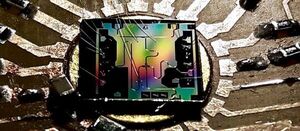
By detecting tiny flashes of heat, scientists pave way for more stable quantum computers
"An international collaboration between quantum scientists resulted in a new way to measure heat dissipation in superconducting quantum circuits – crucial building blocks for quantum technologies such as computers. The discovery represents a step forward for experimental quantum thermodynamics, the field investigating the interaction of the quantum world and heat, and paves the way for improved quantum devices. As heat sets limits for traditional computing, so it does for quantum computers. Detecting and controlling the heat dissipation of quantum computers is central for developing better and more stable machines. Researchers at Aalto, the Universitét Grenoble Alpes and University of Konstanz worked together to test a theory about heat dissipation in a so-called phase slip in a quantum device. The result was a reliable and efficient way to measure dissipation that could be scaled to cover a range of quantum applications." [...]

Ionic Liquids' Good Vibrations Change Laser Colors with Ease
"Method offers approach to shift laser colors for applications in science, industry, and medicine. Lasers are intense beams of colored light. Depending on their color and other properties, they can scan your groceries, cut through metal, eradicate tumors, and even trigger nuclear fusion. But not every laser color is available with the right properties for a specific job. To fix that, scientists have found a variety of ways to convert one color of laser light into another. In a study just published in the journal Physical Review Applied, scientists at the U.S. Department of Energy’s (DOE) Brookhaven National Laboratory demonstrate a new color-shifting strategy that’s simple, efficient, and highly customizable." [...]

Quantum physics: simulation of superconductivity
"A Munich team of researchers has for the first time monitored in an experiment how positive charge carriers in a solid-state model combined to form pairs. This process could play an important role in understanding high-temperature superconductivity. Using a quantum simulator, researchers at the Max Planck Institute of Quantum Optics (MPQ) and the Cluster of Excellence MCQST have observed pairs of charge carriers that may be responsible for the resistance-free transport of electric current in high-temperature superconductors. So far, the exact physical mechanisms in these complex materials are still largely unknown. Theories assume that the cause for the pair formation and thus for the phenomenon of superconductivity lies in magnetic forces. The team in Garching has now for the first time been able to demonstrate pairs which are formed this way." [...]

Multimaterial 3D printing with a twist
"Rotational multimaterial printing of helical filaments for soft robotics and structural composites Materials in nature are rarely straight. In our bodies, proteins assemble into helical filaments which allow our muscles to contract. Plants change shape because cellulose fibers are arranged helically within their cell walls. Scientists that seek to mimic the helical structures that constitute biological systems must create new tools that can precisely pattern different materials with programmable local composition, architecture, and properties. Researchers from the Harvard John A. Paulson School of Engineering and Applied Sciences and the Wyss Institute for Biologically Inspired Engineering at Harvard University have developed a rotational multimaterial 3D printing method for creating helical filaments. Using this new approach, the team designed and fabricated artificial muscles and springy lattices for use in soft robotics and structural applications." [...]

Multi-layered ‘space skin’ can help future satellites and spacecraft harvest energy
"A 'space skin' could help protect spacecraft and satellites from harsh solar radiation while also harvesting energy for future use in the craft's mission, according to a study from the University of Surrey and Airbus Defence and Space. The research team has shown that their innovative nano-coating, called the Multifunctional Nanobarrier Structure (MFNS), can reduce the operating temperatures of space-qualified structures from 120°C to 60°C. Thanks to its custom-built, room temperature application system, researchers were able to show that it is possible to use the MFNS alongside a craft's sensors and advanced composite materials. Professor Ravi Silva, corresponding author of the study and Director of the Advanced Technology Institute at the University of Surrey, said: "Space is a wondrous but dangerous place for us humans and other human-made structures. While solutions already on the market offer protection, they are bulky and can be restrictive when it comes to thermal control. "Our new nano barrier is able to not only provide radiation and thermal protection but also harvest energy for use at a later date."" [...]

Record-breaking detection of radio signal from atomic hydrogen in extremely distant galaxy using GMRT
"Astronomers from McGill University in Canada and the Indian Institute of Science (IISc) in Bengaluru have used data from the Giant Metrewave Radio Telescope (GMRT) in Pune to detect a radio signal originating from atomic hydrogen in an extremely distant galaxy. The astronomical distance over which such a signal has been picked up is the largest so far by a large margin. This is also the first confirmed detection of strong lensing of 21 cm emission from a galaxy. The findings have been published in the Monthly Notices of the Royal Astronomical Society. Atomic hydrogen is the basic fuel required for star formation in a galaxy. When hot ionised gas from the surrounding medium of a galaxy falls onto the galaxy, the gas cools and forms atomic hydrogen, which then becomes molecular hydrogen, and eventually leads to the formation of stars." [...]
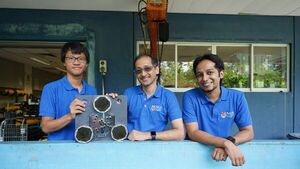
Dolphin-inspired compact sonar for enhanced underwater acoustic imaging
"Operationally fast compact sonar that incorporates sparsity-aware image processing could be used in underwater sensing or navigation. Underwater imaging sonars are an essential technology for ocean exploration. Biomimetic sonars that are inspired from marine mammals such as dolphins are an emerging development in this field. A team of scientists from the National University of Singapore (NUS) Tropical Marine Science Institute (TMSI) has developed a dolphin-inspired compact sonar with a novel echo processing method that allows for clearer visual imaging underwater compared to the conventional signal processing method of visualising sound echoes. The sonar incorporates information on the sparsity of objects which helps interpret sound echoes better. This processing method is based on the hypothesis that dolphins use prior information about their environment, apart from broadband sound pulses, to interpret their echoes." [...]
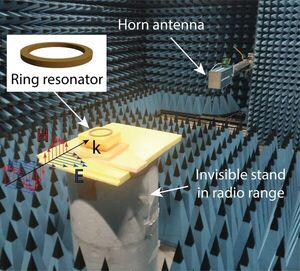
Researchers from ITMO Discover New Photonic Properties of Dielectric Resonators
"We live in a world powered by resonance: there are resonant antennas in our smartphones, and microwaves heat up our food using resonant absorption of electromagnetic radiation by water molecules. Even bridges and skyscrapers remain intact because they were designed to account for the resonance-based nature of various phenomena, such as earthquakes. It is no wonder then that dielectric micro- and nanoresonators are expected to bring about the age of optics, when all electronic devices will be replaced with optical ones. Recently, scientists from ITMO University have contributed to this field by demonstrating new photonic properties of resonators, which make it possible to control their parameters in sensors, detectors, and antennas for different devices. Their study was published in Materials Today. Let’s consider a whispering gallery." [...]
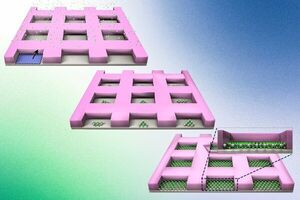
MIT engineers grow “perfect” atom-thin materials on industrial silicon wafers
"Their technique could allow chip manufacturers to produce next-generation transistors based on materials other than silicon. True to Moore’s Law, the number of transistors on a microchip has doubled every year since the 1960s. But this trajectory is predicted to soon plateau because silicon — the backbone of modern transistors — loses its electrical properties once devices made from this material dip below a certain size. Enter 2D materials — delicate, two-dimensional sheets of perfect crystals that are as thin as a single atom. At the scale of nanometers, 2D materials can conduct electrons far more efficiently than silicon. The search for next-generation transistor materials therefore has focused on 2D materials as potential successors to silicon." [...]

Light-based tech could inspire Moon navigation and next-gen farming
"Super-thin chips made from lithium niobate are set to overtake silicon chips in light-based technologies, according to world-leading scientists in the field, with potential applications ranging from remote ripening-fruit detection on Earth to navigation on the Moon. They say the artificial crystal offers the platform of choice for these technologies due to its superior performance and recent advances in manufacturing capabilities. RMIT University’s Distinguished Professor Arnan Mitchell and University of Adelaide’s Dr Andy Boes led this team of global experts to review lithium niobate’s capabilities and potential applications in the journal Science. The international team, including scientists from Peking University in China and Harvard University in the United States, is working with industry to make navigation systems that are planned to help rovers drive on the Moon later this decade. As it is impossible to use global positioning system (GPS) technology on the Moon, navigation systems in lunar rovers will need to use an alternative system, which is where the team’s innovation comes in. By detecting tiny changes in laser light, the lithium-niobate chip can be used to measure movement without needing external signals, according to Mitchell." [...]

Can you trust your quantum simulator?
"A new technique helps verify the accuracy of experiments that probe the strange behavior of atomic-scale systems. At the scale of individual atoms, physics gets weird. Researchers are working to reveal, harness, and control these strange quantum effects using quantum analog simulators — laboratory experiments that involve super-cooling tens to hundreds of atoms and probing them with finely tuned lasers and magnets. Scientists hope that any new understanding gained from quantum simulators will provide blueprints for designing new exotic materials, smarter and more efficient electronics, and practical quantum computers. But in order to reap the insights from quantum simulators, scientists first have to trust them. That is, they have to be sure that their quantum device has “high fidelity” and accurately reflects quantum behavior." [...]

New Small Laser Device Can Help Detect Signs of Life on Other Planets
"UMD-led team developed a miniaturized analyzer that may revolutionize how astrobiology discoveries are made on faraway moons and planets. As space missions delve deeper into the outer solar system, the need for more compact, resource-conserving and accurate analytical tools has become increasingly critical—especially as the hunt for extraterrestrial life and habitable planets or moons continues. A University of Maryland-led team developed a new instrument specifically tailored to the needs of NASA space missions. Their mini laser-sourced analyzer is significantly smaller and more resource efficient than its predecessors—all without compromising the quality of its ability to analyze planetary material samples and potential biological activity onsite. The team’s paper on this new device was published in the journal Nature Astronomy on January 16, 2023. Weighing only about 17 pounds, the instrument is a physically scaled-down combination of two important tools for detecting signs of life and identifying compositions of materials: a pulsed ultraviolet laser that removes small amounts of material from a planetary sample and an OrbitrapTM analyzer that delivers high-resolution data about the chemistry of the examined materials." [...]
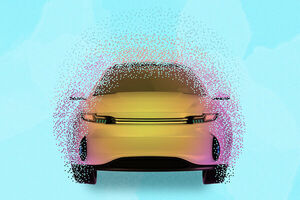
Computers that power self-driving cars could be a huge driver of global carbon emissions
"Study shows that if autonomous vehicles are widely adopted, hardware efficiency will need to advance rapidly to keep computing-related emissions in check. In the future, the energy needed to run the powerful computers on board a global fleet of autonomous vehicles could generate as many greenhouse gas emissions as all the data centers in the world today. That is one key finding of a new study from MIT researchers that explored the potential energy consumption and related carbon emissions if autonomous vehicles are widely adopted. The data centers that house the physical computing infrastructure used for running applications are widely known for their large carbon footprint: They currently account for about 0.3 percent of global greenhouse gas emissions, or about as much carbon as the country of Argentina produces annually, according to the International Energy Agency. Realizing that less attention has been paid to the potential footprint of autonomous vehicles, the MIT researchers built a statistical model to study the problem. They determined that 1 billion autonomous vehicles, each driving for one hour per day with a computer consuming 840 watts, would consume enough energy to generate about the same amount of emissions as data centers currently do." [...]

Artifacts, Begone! NIST Improves Its Flagship Device for Measuring Mass
"For the first time, the NIST-4 Kibble balance directly incorporates a quantum standard for electrical resistance. In a brightly lit subterranean lab at the National Institute of Standards and Technology (NIST) sits a room-sized electromechanical machine called the NIST-4 Kibble balance. The instrument can already measure the mass of objects of roughly 1 kilogram, about as heavy as a quart of milk, as accurately as any device in the world. But now, NIST researchers have further improved their Kibble balance’s performance by adding to it a custom-built device that provides an exact definition of electrical resistance. The device is called the quantum Hall array resistance standard (QHARS), and it consists of a set of several smaller devices that use a quirk of quantum physics to generate extremely precise amounts of electrical resistance. The researchers describe their work in a Nature Communications paper." [...]
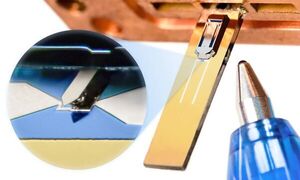
Blast Chiller for the Quantum World
"The quantum nature of objects visible to the naked eye is currently a much-discussed research question. A team led by Innsbruck physicist Gerhard Kirchmair has now demonstrated a new method in the laboratory that could make the quantum properties of macroscopic objects more accessible than before. With the method, the researchers were able to increase the efficiency of an established cooling method by an order of a magnitude. With optomechanical experiments, scientists are trying to explore the limits of the quantum world and to create a foundation for the development of highly sensitive quantum sensors. In these experiments, objects visible to the naked eye are coupled to superconducting circuits via electromagnetic fields. To get functioning superconductors, such experiments take place in cryostats at a temperature of about 100 millikelvin." [...]
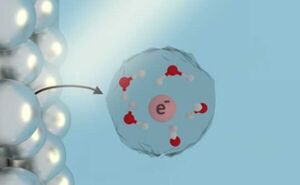
Nanoparticles make it easier to turn light into solvated electrons
"Illuminating study from Rice, UT, Stanford advances ‘green’ reducing agents There are many ways to initiate chemical reactions in liquids, but placing free electrons directly into water, ammonia and other liquid solutions is especially attractive for green chemistry because solvated electrons are inherently clean, leaving behind no side products after they react. In theory, solvated electrons could be used to safely and sustainably break down carbon dioxide or chemical pollutants in contaminated water, but it has been impractical to find out because they’ve been difficult and expensive to make in pure form. That could change thanks to new research from chemists at Rice University, Stanford University and the University of Texas at Austin. In a published study in the Proceedings of the National Academy of Sciences, researchers from the Center for Adapting Flaws into Features (CAFF) uncovered the long-sought mechanism of a well-known but poorly understood process that produces solvated electrons via interactions between light and metal. When light strikes a metal nanoparticle — or nanoscale imperfections on a larger metal surface — it can excite waves of electrons called plasmons. If the frequency of neighboring plasmons match, they can also resonate and reinforce one another." [...]

Approaching the terahertz regime
"Room temperature quantum magnets switch states trillions of times per second A class of nonvolatile memory devices, called MRAM, based on quantum magnetic materials, can offer a thousandfold performance beyond current state-of-the-art memory devices. The materials known as antiferromagnets were previously demonstrated to store stable memory states, but were difficult to read from. This new study paves an efficient way for reading the memory states, with the potential to do so incredibly quickly too. You can probably blink about four times a second. You could say this frequency of blinking is 4 hertz (cycles per second). Imagine trying to blink 1 billion times a second, or at 1 gigahertz; it would be physically impossible for a human." [...]

Scripps Research polysulfates could find wide use in high-performance electronics components
"A new type of polysulfate compound that can form thin, flexible films has properties that could make it a material of choice for many high-performance electrical components, according to a study from chemists and materials scientists at Scripps Research and the Lawrence Berkeley National Laboratory (LBNL). In the study, published January 18 in Joule, the scientists found that the new polysulfates can be used to make polymer film capacitors that store and discharge high density of electrical energy while tolerating heat and electric fields beyond the limits of existing polymer film capacitors. "Our findings suggest that energy-storing capacitors and other devices based on these new polysulfates could see wide application, including in electric vehicle power systems," says study co-senior author Peng Wu, PhD, a professor in the Department of Molecular Medicine at Scripps Research. The other co-senior authors were K. Barry Sharpless, PhD, W.M. Keck Professor of Chemistry at Scripps Research, and Yi Liu, PhD, Facility Director for Organic and Macromolecular Synthesis at LBNL's Molecular Foundry, a multidisciplinary facility for the scientific and technical investigation of new materials. The Sharpless and Wu labs recently synthesized many previously inaccessible polysulfates using the sulfur fluoride exchange (SuFEx) reaction, which was discovered in the Sharpless lab." [...]
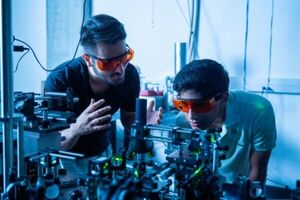
Shedding Light on Quantum Photonics
"As buzz grows ever louder over the future of quantum, researchers everywhere are working overtime to discover how best to unlock the promise of super-positioned, entangled, tunneling or otherwise ready-for-primetime quantum particles, the ability of which to occur in two states at once could vastly expand power and efficiency in many applications. Developmentally, however, quantum devices today are "about where the computer was in the 1950s," which it is to say, the very beginning. That's according to Kamyar Parto, a sixth-year Ph.D. student in the UC Santa Barbara lab of Galan Moody, an expert in quantum photonics and an assistant professor of electrical and computer engineering. Parto is co-lead author of a paper published in the journal Nano Letters, describing a key advance: the development of a kind of on-chip "factory" for producing a steady, fast stream of single photons, essential to enabling photonic-based quantum technologies. In the early stages of computer development, Parto explained, "Researchers had just made the transistor, and they had ideas for how to make a digital switch, but the platform was kind of weak. Different groups developed different platforms, and eventually, everyone converged on CMOS (complementary metal-oxide semiconductor)." [...]
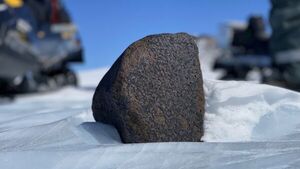
17-pound meteorite discovered in Antarctica
"Antarctica is a tough place to work, for obvious reasons— it’s bitterly cold, remote, and wild. However, it’s one of the best places in the world to hunt for meteorites. That’s partly because Antarctica is a desert, and its dry climate limits the degree of weathering the meteorites experience. On top of the dry conditions, the landscape is ideal for meteorite hunting: the black space rocks stand out clearly against snowy fields. Even when meteorites sink into the ice, the glaciers’ churning motion against the rock below helps re-expose the meteorites near the surface of the continent’s blue ice fields. An international team of researchers who just got back from Antarctica can attest to the continent’s meteorite-hunter-friendliness: they returned with five new meteorites, including one that weighs 16.7 pounds (7.6 kg)." [...]
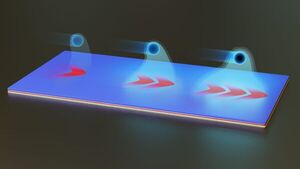
Technion researchers present the first observation of the Cherenkov radiation phenomenon in the two-dimensional space
"Researchers from the Andrew and Erna Viterbi Faculty of Electrical and Computer Engineering at the Technion – Israel Institute of Technology have presented the first experimental observation of Cherenkov radiation confined in two dimensions. The results surprised the researchers when a new record in electron-radiation coupling strength was achieved, and the quantum properties of the radiation were revealed. Cherenkov radiation is a unique physical phenomenon, which for many years has been used in medical imaging, and in particle detection applications, as well as in laser-driven electron accelerators. The breakthrough achieved by the Technion researchers links this phenomenon to future photonic quantum computing applications and free-electron quantum light sources. The study, which was published in Physical Review X, was headed by PhD students Yuval Adiv and Shai Tsesses from the Technion, together with Hao Hu from the Nanyang Technological University in Singapore (today professor at Nanjing university in China). It was supervised by Prof. Ido Kaminer and Prof." [...]
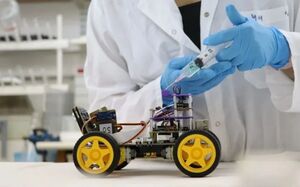
A robot able to “smell” using a biological sensor
"The researchers say that the biological sensor sensitivity to smell is 10,000 times higher than that of existing electronic devices. A new technological development by Tel Aviv University has made it possible for a robot to smell using a biological sensor. The sensor sends electrical signals as a response to the presence of a nearby odor, which the robot can detect and interpret. Link to Research video In this new study, the researchers successfully connected the biological sensor to an electronic system and using a machine learning algorithm, were able to identify odors with a level of sensitivity 10,000 times higher than that of a commonly used electronic device. The researchers believe that in light of the success of their research, this technology may also be used in the future to identify explosives, drugs, diseases, and more. The biological and technological breakthrough was led by doctoral student Neta Shvil of Tel Aviv University’s Sagol School of Neuroscience, Dr. Ben Maoz of the Fleischman Faculty of Engineering and the Sagol School of Neuroscience, and Prof. Yossi Yovel and Prof. Amir Ayali of the School of Zoology and the Sagol School of Neuroscience." [...]
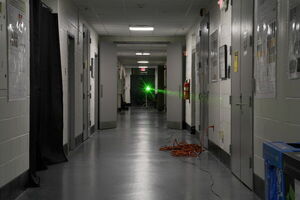
Nearly 50-meter Laser Experiment Sets Record in Campus Hallway
"It's not at every university that laser pulses powerful enough to burn paper and skin are sent blazing down a hallway. But that’s what happened in UMD’s Energy Research Facility, an unremarkable looking building on the northeast corner of campus. If you visit the utilitarian white and gray hall now, it seems like any other university hall—as long as you don’t peak behind a cork board and spot the metal plate covering a hole in the wall. But for a handful of nights in 2021, UMD Physics Professor Howard Milchberg and his colleagues transformed the hallway into a laboratory: The shiny surfaces of the doors and a water fountain were covered to avoid potentially blinding reflections; connecting hallways were blocked off with signs, caution tape and special laser-absorbing black curtains; and scientific equipment and cables inhabited normally open walking space. As members of the team went about their work, a snapping sound warned of the dangerously powerful path the laser blazed down the hall. Sometimes the beam’s journey ended at a white ceramic block, filling the air with louder pops and a metallic tang." [...]

Quantum computers threaten our whole cybersecurity infrastructure: here’s how scientists can bulletproof it
"Thirteen, 53 and 433. That’s the size of quantum computers in terms of quantum bits, or qubits, which has significantly grown in the last years due to important public and private investments and initiatives. Obviously, it is not only a mere question of quantity: the quality of the prepared qubits is as important as their number for a quantum computer to beat our existing classical computers, that is, to attain what’s called the “quantum advantage”. Yet it is conceivable that soon quantum-computing devices delivering such an advantage will be available. How would this affect our daily lives? Making predictions is never easy, but it is agreed that cryptography will be altered by the advent of quantum computers." [...]

New Algorithm Closes Quantum Supremacy Window
"Random circuit sampling, a popular technique for showing the power of quantum computers, doesn’t scale up if errors go unchecked. In what specific cases do quantum computers surpass their classical counterparts? That’s a hard question to answer, in part because today’s quantum computers are finicky things, plagued with errors that can pile up and spoil their calculations. By one measure, of course, they’ve already done it. In 2019, physicists at Google announced that they used a 53-qubit machine to achieve quantum supremacy, a symbolic milestone marking the point at which a quantum computer does something beyond the reach of any practical classical algorithm. Similar demonstrations by physicists at the University of Science and Technology of China soon followed." [...]
Documentação
A documentação é parte essencial do processo de aprendizagem e a Internet além de artigos interessantes de explorar também tem alguma documentação em formato PDF interessante de ler. Todos os links aqui apresentados são para conteúdo disponibilizado livremente pelo editor do livro.
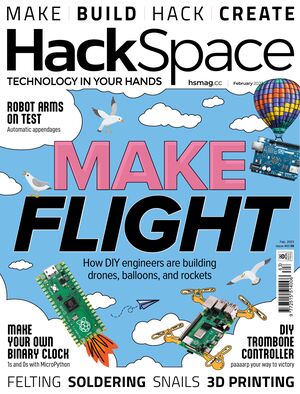
HackSpace magazine #63
"Flying machines: humans have always dreamed about flight, but with our puny arms and lack of feathers it’s something we’ve struggled with. No more! Join us as we explore the best, cleverest and most innovative home-made flying machines. Icarus would have been proud! - Behold: the world's first articulated print-in-place chocolate fish! - When 3D goes so wrong, it's actually kind of right - Build your own trombone-style games controller - Learn to solder - … and loads more!" [...]
Projetos Maker
Diversos Projetos interessantes.
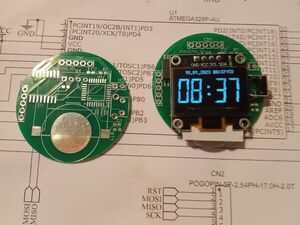
Ultra precise retro style OLED ArduWatch
"Fits in a 40 mm watch case, CR2032 powered Pro-Mini with RTC DS3231, imitates vintage LED watch from the 70' It was starting with experimenting with a RTC Module DS3231 and a UNO.Why the DS3231 ?The DS3231 is a low-cost, extremely accurate I2C real-time clock with an integrated temperature-compensated crystal oscillator The Rodan Library :I was choosing the Rodan Library because it has a good support for setting the date, time with the IDE Serial monitor, see the line// TssmmhhWDDMMYYYY aka set timejust type T005710418012023 + SEND ( Set Terminate to CR ) in the Serial Monitor to setthe Time to 10h57:00 and the date to Wed January 18, 2023" [...]

Led lamp for kid's hat
"It's the dark season again, and time to plaster our child's clothing with reflectors and lights in an effort to increase safety. Hats with front lamps are a thing, and headlamps exist also, but neither seems to work that well for making a kid visible from any direction. So it was time to make my own. I chose to run the LEDs on a single AAA battery to keep the weight down. To step up the voltage I'm using MCP1640 synchronous boost chip. Because MCP1640 fully disconnects the output when off, it is possible to use it also as the main power switch." [...]
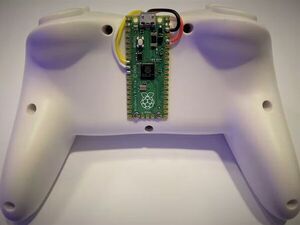
HID Keyboard Device with Raspberry Pi Pico
"Transforms a Wii Classic controller into an HID keyboard. This project is to convert an old Wii Classic Controller into an emulator of an HID keyboard. Each button or action can be mapped into a key press. This is done by using a Raspberry Pi Pico with CircuitPython's HID library. It can easily be modified to do key sequences extremely fast (faster than any human can with their hands), it can be adjusted for games where button smashing is required (don't use it on online competition games). The reason I built it is to control a mobile robot." [...]
Facial Recognition and Tracking Project with mechArm
"This article is a description of the most critical robotic arm control module. I'll give a report on the recent progress of the facial recognition and tracking project. For those who are new, let me briefly introduce what I am working on. I am using a desktop six-axis robotic arm with a camera mounted on the end for facial recognition and tracking. The project consists of two modules: one for facial recognition, and the other for controlling the movement of the robotic arm. I've previously discussed how the basic movement of the robotic arm is controlled and how facial recognition is implemented, so I won't go into those details again." [...]
Driving NeoPixels with Z80
"I've long been thinking about a version two RC2014 LED matrix module. I've had a matrix with a MAX 7219 on a module. It's a nice enhancement. But there's only so much you can do with a single-colour LED array right? Wouldn't it be cool to have RGB LEDs? At Liverpool MakeFest I saw a wall-sized ping-pong ball NeoPixel display and picked up some NeoPixels with the intention of making one." [...]
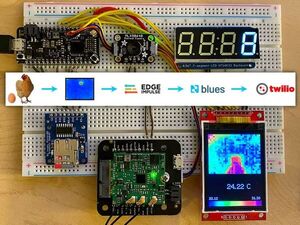
ID Chicken Eggs with Thermal Images, ML, and Cellular IoT
"In part one of a two-part project, we display thermal images on a TFT display, save them to flash, all to build an ML model w/ SMS alerts! One thing they don't tell you about raising chickens in the frozen tundra of Wisconsin, is how you're routinely putting your life on the line just to go check for eggs. As much as I'm willing to sacrifice my own children in the name of looking for an egg, I'd prefer to create an ML + IoT solution that can do it for me! And maybe save a child along the way. In this two-part project, we will walk through how to create a Machine Learning-based IoT solution to detect the presence of a chicken egg using images provided by a thermal IR camera, relaying those inferences to the cloud using a cellular module, and sending an SMS notification if an egg is detected. Part one (today) covers the hardware, wiring, and firmware needed to capture a thermal image, save it to an SD card as a PNG, and connecting to the cloud." [...]

Precision Motor Controller with LM629 and PIC MCU
"Control up to 4 motors with high precision using quadrature encoders, can be added to robots or create CNC machines. Background and Theory The purpose of this project is to create a system that give precise control of speed, acceleration and motion to motors. Although stepper motors can provide high torque and are highly synchronized to the inputs (therefore the microcontroller controlling it can keep track of their current position), they are not efficient while running, it will severely affect the time a battery can last. Also, if for some reason the stepper motor stalls, there is no way for the controller to know that it didn't move but it will register as if it had, this will throw the whole system into chaos (imagine a 3D printer skipping a step because it got jam, the whole printing will be messed up from the event of occurrence). For this reason, I have implemented a system that can control DC motors with feedback to keep track of what has the motor done regardless of the amount of PWM cycles, stalls, etc. This requires the motors to have quadrature encoders (for this analog/power board the motors must be 12V-24V), the LM629 precision motor controller, and a microcontroller to setup the LM629 ICs." [...]
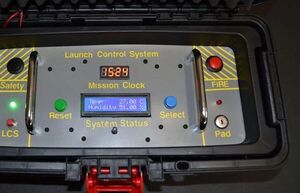
The Arduino Launch Control System (LCS)
"The Arduino Launch Control System is a model rocket launch controller for a single rod launch pad. This was the first Arduino rocketry project that I wanted to design and build, having just started into learning about electronics and the Arduino less than 6 months prior. There are a number of Arduino model rocketry launch projects available on the Internet, and they did provide inspiration for this project. Yet while they provided some great ideas, I wanted to approach this launch control system from a different angle. Focus on Research If you look around my web site (https://rocketryjournal.wordpress.com), you know that I often discuss how model rocketry can be used to explore both science and technology. One great way to combine these is to use model rocketry as part of a science or technology fair project." [...]

Beep Beep
"In order to prevent colony collapse syndrome, we have created an autonomous embedded system to help beekeepers During our 4th year at Polytech Sorbonne, we took part in the conception and set-up of a monitoring embedded system applied on hives in order to help beekeepers watch the activity of bees and face CCD : Colony Collapse Disorder. With this system, we can collect the following data : - The weight( to prevent the decrease of the number of the bees or robbery) - The temperatures and humidity( inside and outside )the hive to prevent CCD which is especially threatening during winter. - The lux ( here in percentage depending on the voltage we can see on the solar panel) - The level of our battery(since we are using to supply the system; the solar panel to recharge allows the system autonomy) - Some bands of frequencies: First because we can and then because it can useful to determine the state of the bees(rest, stress or work) All the components will be put in a waterproof box. The microphone, the weight sensor, the box and the temperature & humidity (DHT22) sensor will be under the beehive. Temperature sensors (DS18B20) will be put inside the beehive. The solar panel will be placed on the roof." [...]
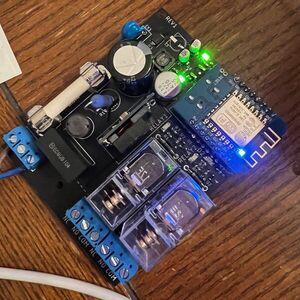
Home Assistant Heating Controller
"I’ve been using Home Assistant to automate my house, and one of the big things I want to add control of is my heating. The heating system in my house is a little different to a typical British home in that I have zones, one for upstairs (radiators) and one for downstairs (underfloor heating). This means a lot of the off-the-shelf thermostat options, especially Google Nest, aren’t suitable for me, and what options there are have a prohibitive cost. A commercial option would be something by Hive, they support multi-zone thermostats and they are supported in HomeAssistant. Sadly, this option would cost about £300. Home assistant to the rescue, it has a built-in integration for controlling heating, so long as you provide it a switch to toggle the heating, and a sensor to read the current temperature." [...]

Optical Glove Controller using LDR
"Use an inexpensive Light Dependent Resistor to control servos with a glove interface. A student at the high school where I teach has designed a laser-cut acrylic hand with movable fingers. He wants to control the fingers individually. It occured to me that a glove-based controller would be a great way to move the fingers. Move your index finger and it moves the hand's index finger. Flex sensors can be expensive." [...]

Number Maze Game
"This is a handheld game that displays a 4x4 matrix of numbers representing a logic maze, and you have to solve the maze by pressing the buttons Your position in the maze is shown by the decimal point, and you can move it around the maze using the four arrow buttons. If you get to Home, labelled H, the speaker plays a tune, and you can then move to the next maze. The game contains a series of 12 different mazes of increasing difficulty. It's based on four low-cost 4-digit seven-segment displays controlled by an AVR128DA32 microcontroller, and it's powered by two AA cells. Introduction At about this time of year I try and think of a game project to build as a present for one or two younger friends and relations. This year I've come up with an electronic version of a classic type of logic maze, called a Number Maze or Jumping Maze [1]." [...]
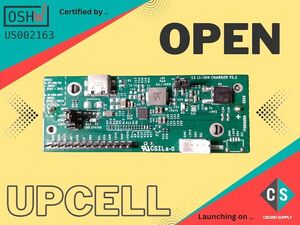
Open UpCell
"Open-source USB Type C PD board for 1S Lipo or Li-ion cell or cell with similar chemistry. We have attended a lot of hackers events online as well as offline, watched a lot of videos, build a lot of project & we have noticed a problem faced not only by us but is also faced by a lot of makers as well and that was to power the project. So, we decided to attack on the problem to help makers community integrate the power easily in their project so that they can focus on their innovative solution instead of wasting time on building power connection.I major features we have in mind while building it were - Easier integration, play & play solution - Must be able to power hungry projects, Raspberry pi as well - Easily replaceable battery - Fast charging - Easy switching b/w 3.3V & 5V output And our final comes with all of these and the cherry on the top is it's completely Open Source as well. Features: - Short-circuit protection - Temperature loop control - Input over-voltage protection - Input over-current protection - Over-charge protection - Fused input - Trickle charging Specification: - 3.3V/5V output options - STEMMA QT connector - SEEED GROOVE connector - Battery gauge over I2C - Charge control, status, and monitoring over I2C - 1.8v. 3.3v, and 5V compliant I2C - Arduino IDE SDK for I2C communication (Under Developement) - MicroPython SDK for I2C communication (Under Developement) - 5V, 9V, 12V USB PD and fast charging capable (Up to 14V or 3A) - Compatible with any capacity of Li-Po or 18650 cells, 21600 cells, or equivalent lithium chemistry cell. Not only this but also we are actively working on it's enclosure which can be easily 3D printed using any 3D printer w/o support and it will be completely screwless & also there will be no need of glue/tape to fix it in place." [...]

OverEngineered Pen Holder
"A Pen Holder made from PCBs and 3D Printed parts in an OverEnginnered Way. The concept of this story was that after using a mug as a pen holder for some years, it was time for an upgrade—an OverEngineered upgrade. I utilized four square PCBs and a few 3D-printed components to create a new pen holder. Three PCBs are only there for aesthetic purposes, but the one on the backside of the device has a power management IC that is being used to operate any 5V device, such as an Arduino board, or even charge a smartphone. It also has a few RED LEDs that light up the entire system and make it appear like a lamp in the dark. A 3D-printed pen holder would be easy to make, but where's the fun in that?" [...]
DNS DriveBy: Stealthy GPS Tracking Using Open Wi-Fi
"How I created a $10 ESP8266 GPS Tracker that uses Open Wi-Fi networks & DNS exfiltration for communication. Low-Cost Tracking Challenge In a recent Hak5 episode, I took part in a challenge to track our elusive friend, Irish, and determine the various places he visited throughout the day. Since low-cost hardware & disposable signals intelligence is a core part of my projects, I challenged myself to create a tracker in the smallest practical footprint, and designed a $10 device that uses only Wi-Fi to provide location updates once planted on Irish's car. Using DNS Exfiltration, CanaryTokens, an an ESP8266 with specialized low-power hardware, I created a motion activated tracker that could transmit intermittent location updates, by connecting to open Wi-Fi networks that Irish would drive past. " [...]
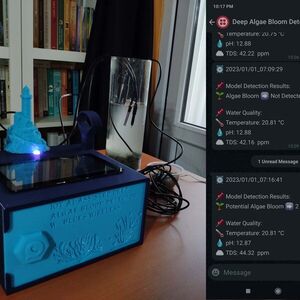
IoT AI-assisted Deep Algae Bloom Detector
"Take deep algae images w/ a borescope, collect water quality data, train a model, and get informed of the results over WhatsApp via Notecard In technical terms, algae can refer to different types of aquatic photosynthetic organisms, both macroscopic multicellular organisms like seaweed and microscopic unicellular organisms like cyanobacteria[1]. However, algae (or algal) bloom commonly refers to the rapid growth of microscopic unicellular algae. Although unicellular algae are mostly innocuous and naturally found in bodies of water like oceans, lakes, and rivers, some algae types can produce hazardous toxins stimulated by environmental factors such as light, temperature, and increasing nutrient levels[2]. Since algal toxins can harm marine life and the ecosystem detrimentally, algal bloom threatens people and endangered species, especially considering wide-ranging water pollution. A harmful algal bloom (HAB) occurs when toxin-secreting algae grow exponentially due to ample nutrients from fertilizers, industrial effluent, or sewage waste brought by runoff in the body of water. Most of the time, the excessive algae growth becomes discernible in several weeks and can be green, blue-green, red, or brown, depending on the type of algae." [...]

AD9833 Function Generator
"Build a function generator with an Arduino Nano and a AD9833 Programmable Waveform Generator module. The purpose of the project was to test the Analog Devices AD9833 Programmable Waveform Generator chip. On eBay, Ali-Express and other similar sites you can purchase a AD9833 module for around $5 including shipping. FEATURES - Digitally programmable frequency and phase - 12.65 mW power consumption at 3 V - 0 MHz to 12.5 MHz output frequency range - 28-bit resolution: 0.1 Hz at 25 MHz reference clock - Sinusoidal, triangular, and square wave outputs - 2.3 V to 5.5 V power supply - No external components required - 3-wire SPI interface - Extended temperature range: −40°C to +105°C It is a very impressive module and with that endorsement, the original project was extended to become a useful tool for the work bench. " [...]

Counting the transistors in the 8086 processor: it's harder than you might think
"How many transistors are in Intel's 8086 processor? This seems like a straightforward question, but it doesn't have a straightforward answer. Most sources say that this processor has 29,000 transistors.1 However, I have traced out every transistor from die photos and my count is 19,618. What accounts for the 9382 missing transistors? The explanation is that when manufacturers report the transistor count of chips, typically often report "potential" transistors. Chips that include a ROM will have different numbers of transistors depending on the values stored in the ROM." [...]
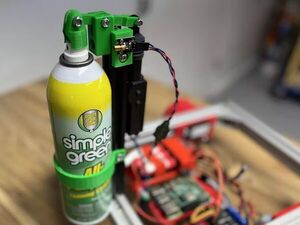
SprayMaster
"3D Printable Autonomous Sprayer for SCUTTLE When I saw this 12v Door Lock actuator for $5, I immediately saw the SpayMaster! You can get all parts for under $30. All of the screws are M5 size, except the long M3x50mm. Print the parts in just 2 hours on any cheap printer. This design can stand alone with any microcontroller, or you can add it to your SCUTTLE Robot! I hope you get creative with this and make a new application." [...]

Linear Scale ТЕА5767 FM Radio on ili9341 TFT Display
"Simple FM Radio with a beautiful retro look linear scale. This time I will present you how to make a simple FM Radio with a beautiful retro look linear scale. The idea for the project was taken from the Volos Projects channel, where is presented the code that was specially made for the LilyGO T-Embed device, which has a TFT screen with a resolution of 320 x 170 pixels. I just adapted the code for the ILI9341 TFT Display which has a resolution of 320×240 pixels powered by an ESP32 dev kit module. The radio interface is the same, and in the remaining part of the screen I added a small clock that shows the time. Actually, as a beginner in programming, I did a little practice drawing figures and placing text on the Display." [...]
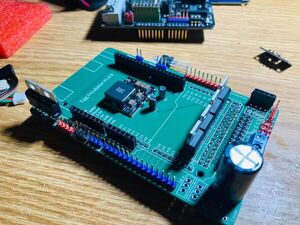
Chicken Egg Incubator with Arduino
"This is a tutorial for how to make a DIY chicken egg incubator from scratch (pun intended) with Arduino! Fully automated incubator! Story I have some chickens, but I want some more! Buying chicks at the store would be way too easy, so I decided to build myself an incubator! What is an Incubator An incubator is a device that hatches eggs. It keeps a space at a certain temperature and humidity for a certain amount of days, till the eggs hatch." [...]
Secção Videos
Videos interessantes.
That's all Folks!




